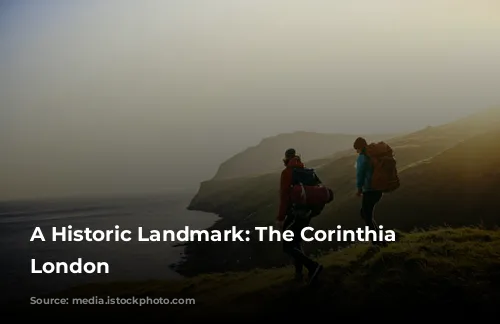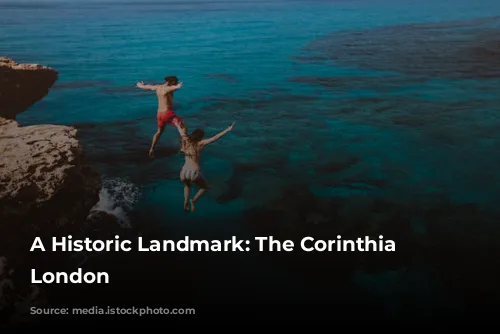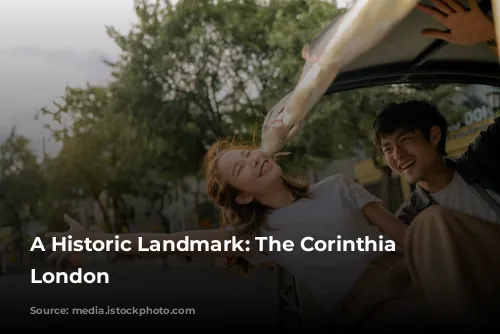The Corinthia Hotel London, situated at the corner of Northumberland Avenue and Whitehall Place in the heart of London, stands as a majestic landmark with a rich history woven into its very fabric. This grand hotel, once a British Government building, occupies a prominent triangular plot between Trafalgar Square and the Thames Embankment. Its strategic location near the Palace of Westminster and Whitehall government offices played a pivotal role in its past.
A Changing Landscape: From Luxury to Government Offices
Originally opened in 1885 as the Metropole Hotel, this opulent establishment drew dignitaries and travelers alike. The hotel’s prime location made it a natural choice for government requisition during both World Wars. Following World War II, the Ministry of Defence acquired the building, transforming it into government offices. Its purpose shifted again in 2007 when it was deemed surplus to requirements and sold by Crown Estates. The building then embarked on a journey of restoration, eventually emerging as the prestigious Corinthia Hotel, a fusion of hotel and luxury residences.
A Gathering Place for Elite and Events:
The Metropole Hotel, in its early days, became a focal point for social gatherings and elite events. The annual dinners of the Aero Club and the Alpine Club were hosted within its walls for many years. The hotel served as the starting point for the inaugural London to Brighton run in 1896, a landmark event in motor racing history. Notably, the Prince of Wales, later King Edward VII, was a frequent guest at the hotel, reserving a box in the grand ballroom and utilizing the Royal Suite. This suite, believed to be located on the first floor with bowfronted windows overlooking Whitehall Place, provided the King with a luxurious retreat.

A Pivotal Role in World Wars:
The hotel’s role in the nation’s wartime efforts cannot be overlooked. In the lead-up to World War I, the building was requisitioned to provide accommodation for government staff. Its location made it an essential resource for those working tirelessly to maintain national security. The night before the British Expeditionary Force embarked for France at the outbreak of war in August 1914, the two Commanders-in-Chief, Field Marshals John French and Douglas Haig, both chose to stay at the Metropole. This significant event solidified the hotel’s importance as a symbol of national resilience during times of crisis.

Entertainment and Cultural Significance:
The Metropole Hotel’s transformation into a hotel after World War I brought a new era of entertainment to its halls. The “Midnight Follies” became a celebrated cabaret fixture, drawing crowds with its dazzling performances. In 1921, Bert Firman joined the Midnight Follies Orchestra as a violinist. Fate intervened when the bandleader, an American saxophone player known for his excessive alcohol consumption, fell ill. Firman, a mere sixteen years old, was offered the position, becoming, according to his own claim, the youngest bandleader in the world. The hotel’s stage continued to resonate with music throughout the inter-war years, with renowned bandleader Mantovani adding his touch to the vibrant atmosphere.

A Historic Sporting Moment:
The year 1936 brought a momentous sporting event to the Metropole Hotel. On January 4th, the England Rugby Union team, led by the legendary Prince Alexander Obolensky, triumphed over the touring New Zealand All Blacks. This victory, marked by Obolensky’s three tries, including a widely acclaimed try that defied the All Blacks’ defense, marked a historic first: England’s first ever victory over New Zealand. The England team, celebrating their triumph, retreated to the Metropole for the night, where they found their opponents, the New Zealand team, also staying at the hotel. This unexpected encounter added a touch of camaraderie to the post-match festivities.

From Hotel to Government Offices:
The government’s redevelopment of buildings at Whitehall Gardens in 1936 led to a new lease on life for the Metropole Hotel. The government leased the entire hotel for a hefty sum, transforming it back into government offices. Initially housing the Ministry of Labour and the Ministry of Transport, the building later accommodated the Air Ministry and the Ministry of Defence. This move signified the hotel’s transition from a luxury retreat to a vital center for government operations.

A Crucial Role in World War II:
The looming threat of World War II prompted the government to extend its lease on the building. As the nation braced for conflict, the Metropole once again became a haven for various government departments. Room 424 gained notoriety as the first home for MI9, the intelligence agency responsible for espionage and sabotage operations. The building also served as a vital holding point for the model planning beaches for Operation Overlord, the Allied invasion of Normandy. This wartime role showcased the hotel’s strategic importance in safeguarding national security.

A Legacy of Government Use:
Following World War II, the Metropole was acquired by Gordon Hotels and subsequently transferred to the Crown Estate portfolio. The Ministry of Defence took control, using the building as an overflow for its main Whitehall complex. From the mid-1960s to 1992, the Defence Intelligence Staff made the building its home, while the remainder of the analysts and central staff were stationed in the MoD Main Building. The James Bond comic strip in the Daily Express featured the Metropole building as MI6 headquarters, cementing its image as a hub of espionage and intrigue. The building’s role as a government office continued during various MoD refurbishments, with its mirrored ballroom becoming a stage for press conferences and other major events.

A New Chapter: The Corinthia Hotel
Standing vacant since 2004, the Metropole building, alongside its neighboring property, 10 Whitehall Place, was acquired in 2007 for a significant sum by a consortium led by Malta’s IHI plc. The City of Westminster council approved the development of the two buildings as a hotel and residential complex in 2008. In 2011, the building reopened under the banner of Corinthia Hotels International, ushering in a new era for this historic landmark. 10 Whitehall Place was transformed into 12 elegant residences, complemented by a luxurious spa run by Espa.

A Nod to the Past:
The Corinthia Hotel, honoring its rich history, served as the venue for the official announcement of the James Bond movie Skyfall in November 2011. This symbolic gesture highlighted the building’s connection to the world of espionage and intrigue, which had been cultivated during its years as a government office.

A Cinematic Presence:
The Corinthia Hotel further solidified its connection to the world of entertainment by providing a stunning backdrop for the 2018 thriller “Red Sparrow.” Scenes were filmed both inside and outside the hotel, showcasing its architectural grandeur and sophisticated ambiance. The film’s press junket and photocall were also held at the hotel, adding another layer of cinematic prestige to its legacy.

A Platform for Artistic Expression:
Since 2011, the hotel has hosted an “Artist in Residence” program, a platform for showcasing talent and fostering artistic expression. This unique program invites writers, theater companies, and filmmakers to present their work, with the selected performer typically being the winner of a national competition. The opera “Found and Lost,” by artist-in-residence Emily Hall, graced the hotel’s stages in January and February 2016, highlighting the Corinthia’s commitment to supporting the arts.

A Legacy of Transformation:
The Corinthia Hotel London stands as a testament to the enduring power of a building’s history. From its beginnings as a grand hotel to its years as a government office, and its current incarnation as a luxurious retreat, this landmark has witnessed and played a pivotal role in shaping London’s social, political, and cultural landscape. The hotel’s transformation reflects the dynamism of the city itself, a constant evolution that blends tradition with innovation. The Corinthia Hotel, with its captivating history and present-day grandeur, continues to be a beacon of elegance, intrigue, and artistic expression in the heart of London.

